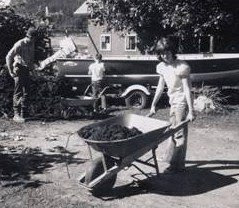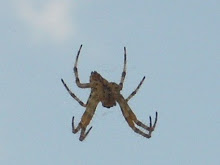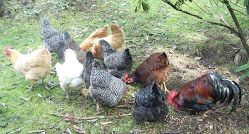 When I was growing up composting was just something we did. Every kitchen scrap was put in the green bowl by the sink and then later buried between the rows in the garden. Each fall, after the big storms, we went to the beach and hauled, what seemed like tons of the seaweed that had washed up, home to the compost pile. In the spring we added what we called “barn scrapings” after considerable effort shoveling. Imagine my surprise when at some point I realized that not everyone composted. It still seems odd to dump food scraps into the trash when I am not home. As an adult, composting is still the way in my life. It is the ultimate recycle and you should all be doing it in some form or another. It is an inexpensive source of nutrients and keeps the energy in your own gardening system not the landfill!
When I was growing up composting was just something we did. Every kitchen scrap was put in the green bowl by the sink and then later buried between the rows in the garden. Each fall, after the big storms, we went to the beach and hauled, what seemed like tons of the seaweed that had washed up, home to the compost pile. In the spring we added what we called “barn scrapings” after considerable effort shoveling. Imagine my surprise when at some point I realized that not everyone composted. It still seems odd to dump food scraps into the trash when I am not home. As an adult, composting is still the way in my life. It is the ultimate recycle and you should all be doing it in some form or another. It is an inexpensive source of nutrients and keeps the energy in your own gardening system not the landfill!There are many ways to compost and once again I recommend research (friends, online, seed catalogs) and experimenting to find what will work best for you. There are two kinds of composting hot (which kills lots of seeds and things but the temperature can be hard to maintain) and warm. I prefer warm because it takes the least effort on my part and encourages worms to hang out – worms make the very best fertilizer (worm castings) there is!
This is what I know about composting...
It is important to find the right kind of container that will meet your needs. As you research you will find many types of composters. What you use will depend on what kind of space and resources you have. If the yard is small and/or completely landscaped, the commercial varieties work well since they don’t take up much space and are nice looking. My mom now uses one because her neighborhood has grown since I was young and she has to have a more secure situation to keep the dogs and black bears out. Some of these pictures are of the setups I have around my yard which is not small or highly landscaped. The others are from Mom's yard. They all work. Another consideration will be size and that is something to figure out as you compost. The key is to be flexible since your composting adventure may change, depending on who is eating at your house, how much energy you put in to pulling weeds and/or mowing, or changes in the season.




Next, what should you put in it? Kitchen scraps are great. Unlike my mother who used to have the luxury of putting everything into her compost because nothing bothered it, I sort. I have two buckets in the kitchen, one for the chickens and one for the compost pile. Just as a side, chickens will eat anything you could eat (not that you would) such as apple, carrot and pear peals, moldy bread, left over pasta and rice, etc. If you don’t have chickens, it can all go to the compost. The only thing I don’t include is meat and cheese. I don’t want to encourage critters like raccoons…and the dog prefers it in his bowl anyway. Very little food goes into the trash or down the disposal.
 Yard waste makes excellent compost fodder. A mix of green and brown is the optimum…Green being grass clippings and weeds. Grass is great in the compost but too much can slow decomposition and may get sour and stink. In any type of gardening there seems to be plenty of weeds. I put them all in the compost, but try to harvest before they have mature seeds. That doesn’t always happen so I put seeds into another pile to use in later years. Mix in brown which would be leaves (my mother-in-law calls leaves “gold” as far as an ingredient in her compost pile) and plant stalks cleaned out of the garden. I stockpile leaves in the fall to be added throughout the year (another pile). Don’t include sticks and twigs unless they are chipped, because it takes too long for them to break down.
Yard waste makes excellent compost fodder. A mix of green and brown is the optimum…Green being grass clippings and weeds. Grass is great in the compost but too much can slow decomposition and may get sour and stink. In any type of gardening there seems to be plenty of weeds. I put them all in the compost, but try to harvest before they have mature seeds. That doesn’t always happen so I put seeds into another pile to use in later years. Mix in brown which would be leaves (my mother-in-law calls leaves “gold” as far as an ingredient in her compost pile) and plant stalks cleaned out of the garden. I stockpile leaves in the fall to be added throughout the year (another pile). Don’t include sticks and twigs unless they are chipped, because it takes too long for them to break down.Maintaining the compost pile is simple. The one and only thing absolutely required is adequate water. If it hasn’t rained in a while, a good soaking with the hose is helpful. Stirring occasionally will speed up the decomposition process. Then just sit back and let the worms and their friends (bacteria, fungus, microbes, bugs) do the work. Some may be concerned about the smell but if your set up is decomposing correctly the only odor should be a yummy dirt smell.
Now use it...compost can be used all over the yard as a top dressing or mulch around landscape plants, in the bottom of pots or I mix it into all of my raised beds before planting. The timing is important and depends on what is in the pile and how much tending it got. If most of the ingredients are still recognizable, it hasn’t been long enough. If all I see is mostly dirt with a few corn cobs, egg shells and peach pits, it’s ready. In the three-bay compost, I generally add to one, the second is decomposing and the third I distribute. One hint, as lovely as compost is, it takes a lot of nitrogen to break it down, so I mix in a little blood meal or other natural source of nitrogen as I spread it around. The only drawback is that I could always use more than I have.
So whether you just deposit your leaves and grass clippings behind the shed or compost everything possible, your yard will benefit and you are doing an easy little thing to help take care of the earth!














I'm trying to do more that this year with kitchen scraps--we've always done the leaves
ReplyDeleteI went to a class about it at the murray library with a horticuligist --and so I'm all fired up about it too
My brother recently got into composting when they moved into their new house out in Missouri. I thought he was a little crazy, but at the same time couldn't help but be intrigued. He and I are a lot alike... give us a science experiment to conduct and we'll watch the results with fascination. :)
ReplyDeleteI'm not sure if he still composts, but I'm going to refer him to this blog anyway (just in case)!
sara- your reading my mind. our house has what used to be a composite pile...now not so much anymore that i have been thinking about turning back into a working one. thanks for the tips!
ReplyDelete